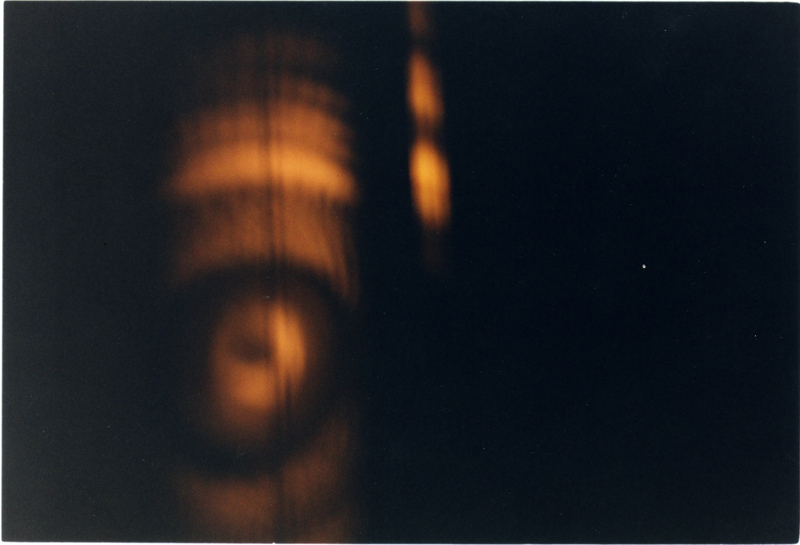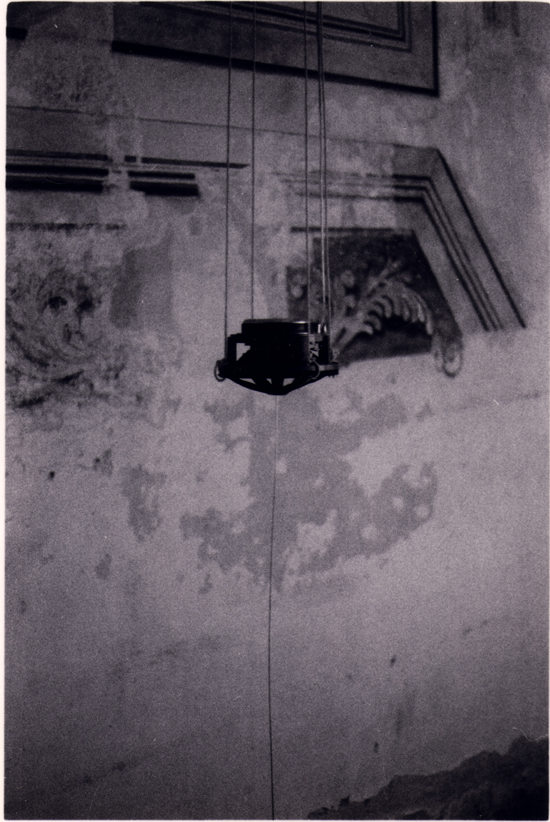
THE BLOW: THE BATH, 2018 (Video)
The video, The Bath, was produced by Melissa Dyne and Khaela Maricich working in collaboration as The Blow, during an artist residency at Etopia Centro de Arte y Technologia, in Zaragoza, Spain. The video documents a projection of analog video synthesis, melding sound and light through control voltage. The audio recording of The Bath was a live composition performed in one take by Dyne using her rig of modular synthesis, analog synths, delays, and other audio processing gear. The Bath was performed live as part of the performance Energetic Strategies (For Right Now), which toured throughout the United States in the fall of 2018.
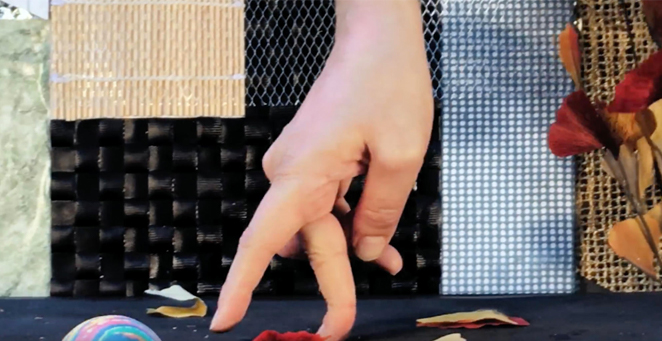
THE BLOW: THE WOMAN YOU WANT HER TO BE, 2017 (Video)
The Woman You Want Her To Be is a one-take video made by Melissa Dyne and Khaela Maricich, collaborating as The Blow. The video accompanies a song which was composed over an extended time span: first performed in the “UNPLUGGED” performance series as a string of gibberish summarizing the experience of the patriarchy, the lyrics of the song The Woman You Want Her To Be were articulated over time and in public, culminating in a release on the 2017 album “Brand New Abyss” and tour of the same name. The instrumentation was produced with Dyne’s performance and production rig, developed to produce multiple layers and qualities of sound with one sound source. The composition of the song was made, like the video, in one take, constructed from a single multi-channel performance of a synthesizer playing through numerous signal processors, producing an expansive sonic field created by a single instrumentalist. The video features a hand performance by Melissa Dyne.
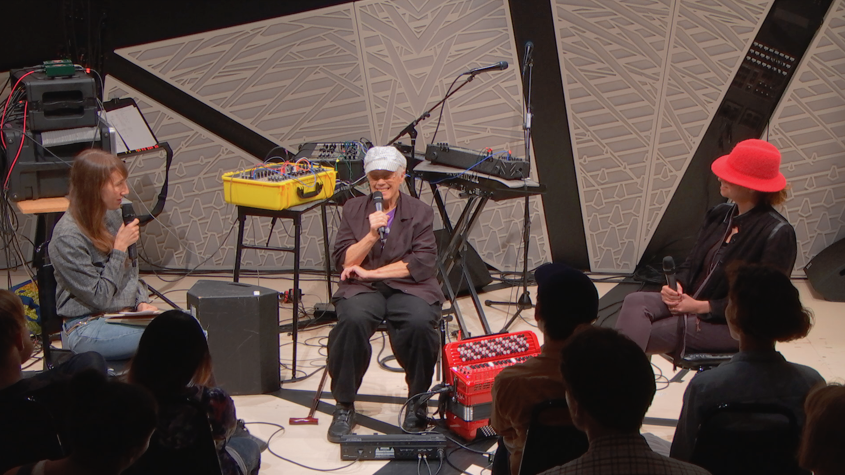
WOMANPRODUCER, 2016 (Performance and Lecture Series)
WOMANPRODUCR is a multi-platform archive of female, trans, and gender non-conforming sonic innovators, curated by Melissa Dyne and Khaela Maricich (pictured above with modernist composer and early electronic innovator Pauline Oliveros, seated at center). In 2016 WOMANPRODUCER hosted a multi-evening series of events bringing together producers and technologists from across a range of musical genres and eras for conversations and performances, held at National Sawdust in Brooklyn, NY. Particants included Pauline Oliveros, Neko Case, Suzi Analogue, Yuka Honda and Miho Hatori of Cibo Matto, Val Jeanty, Zola Jesus, The Blow, and Mirah. The above image is of a panel discussion on music production and innovation, a video of which, along with other archives of producers and technologists, can be seen at womanproducer.com.
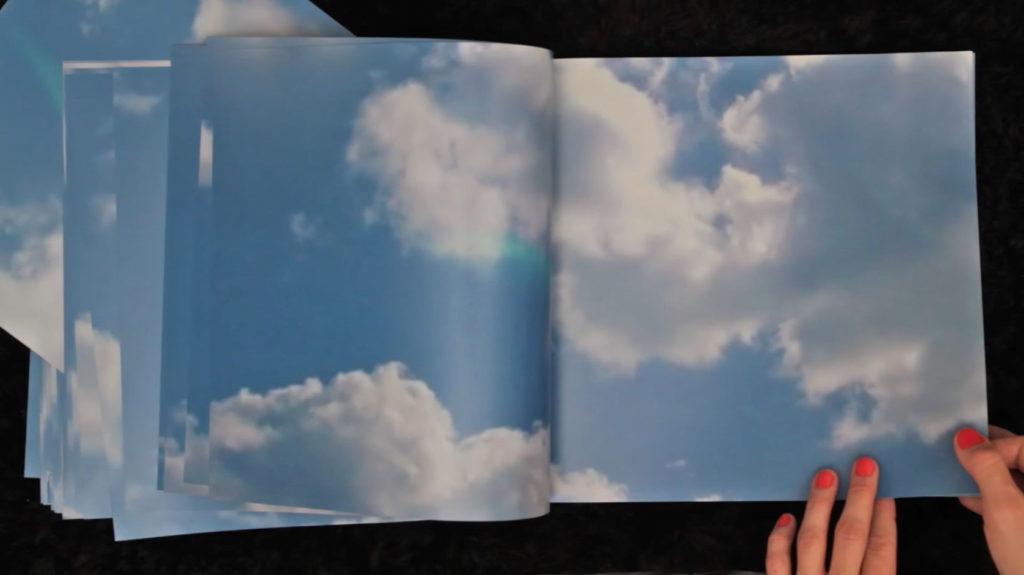
THE BLOW: FROM THE FUTURE, 2013 (Video)
From The Future is a video made by Melissa Dyne and Khaela Maricich, collaborating under the name The Blow. The video features the song “From The Future,” released on the self-titled LP “The Blow” in 2013. Made while Dyne was in the process of developing her performance and production rig, the compositions were created in a manner of electronic musique concrète: samples of live instrumentation from musicians working across a range of genres in New York City were recorded, processed and montaged to produce new sonic materials. A number of samples were recorded of Bashiri Johnson, the acclaimed pop percussionist for Michael Jackson and Madonna’s first record, among many others. The album was accompanied by a live performance titled “We Put It Together So We Could Take It Apart,” commissioned by Portland Institute of Contemporary Art and toured throughout the US and Canada. The album was listed among the top-ten songs of 2013 by New York Times, and was NPR music editor Bob Boilen’s #1 album of the year. The video and book (created by Maricich for the video) were exhibited in the group exhibition “This Summer…” at Interstate Projects, Brooklyn, in 2014.
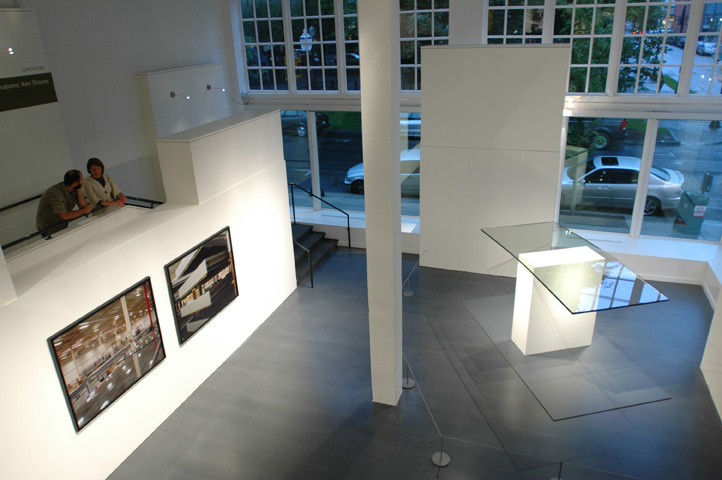
GLASS, 2008 (Site-specific solo exhibition)
Glass was a site-specific solo exhibition at the Museum of Contemporary Craft in Portland, OR. For the installation, a pane of 5 × 11 engineered glass weighing half a ton was draped over a wall and left to bend by its own weight over the span of three months. The pane was originally produced by Benson Industries for use in the 2007 New York Times building. The properties of Benson glass placed in this position had never before been tested; whether the glass would shatter, if so how, and when this might occur were unknowns. These uncertainties allowed for the performance of an object, the dangerous potential of the glass dictating the visual outcome and interaction with the audience for the duration of the exhibition. The concept of performing collaboratively with an object is a recurring focus throughout all of Dyne’s work.
The balancing glass was accompanied by two 5′ x 6′ large-format photographs of the glass pieces in states of storage and assembly at the Benson Industries facilities. Hung side by side, the photographs created a stereoscopic perceptual illusion. Drawing parallels between the warehouse as a site of industrial production, and the culturally charged contemporary art space (the “White Cube”), the exhibition turned the Museum into a laboratory for open-ended questions.
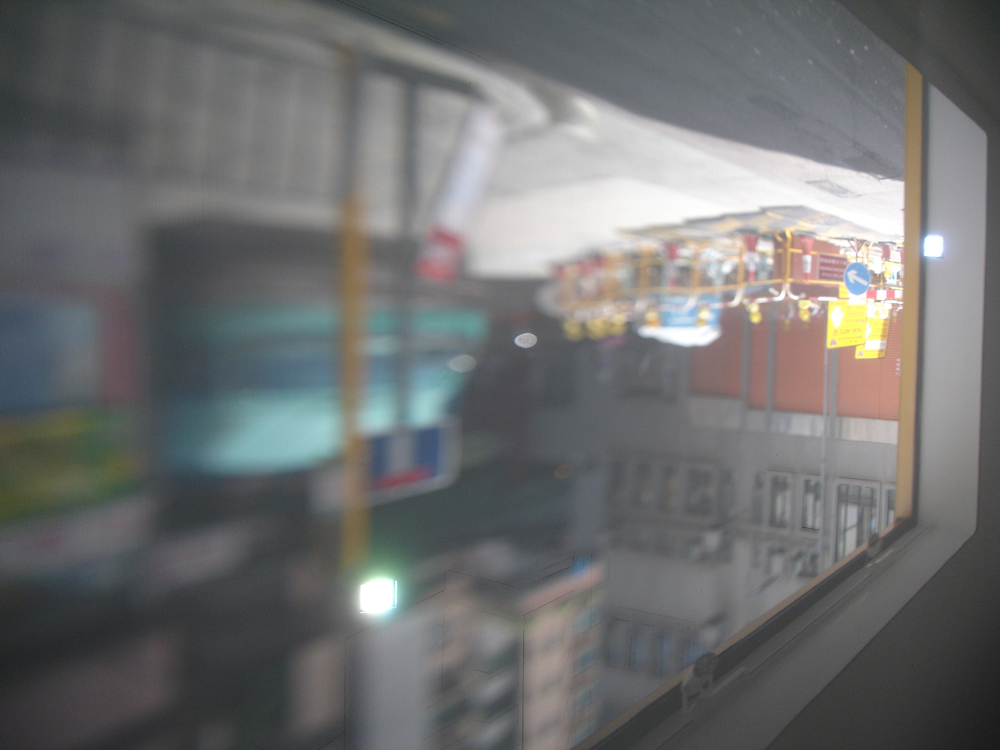
BIG TOOLS/SMALL TOOLS, 2005 (Collaborative site-specific installation)
Big Tools/Small Tools was a collaborative installation created with Kathy High at Para/Site Art Space in Hong Kong, China. Using small video monitors with a large scale projected image of the live street scene, this collaborative installation looked at space through the use of a camera obscura lens system combined with multiple images of spy and toy video cameras.
The image of the street outside the Para/Site Art Space was projected via a camera obscura onto a gallery wall. Embedded within that projected image were multiple small video monitors displaying details of the same street scene. The camera obscura and the small video displays were live, allowing interaction from the street to the space as people discovered the various camera sources. The combined pictures revealed different systems of viewing – one older optical system which is closer to the workings of the eye, and one comfortably similar to the digital barrage we see daily – to expose how we view things as opposed to what they represent. The installation was created during an artist-residency sponsored by the Asian Cultural Council and the Art School of Hong Kong Arts Centre.
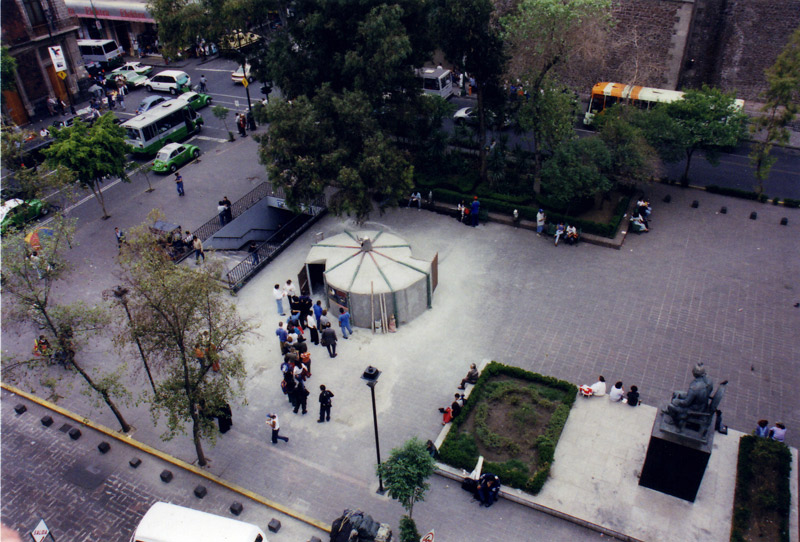
CAMARA OBSCURA, 2002 – 2003 (Site-specific solo exhibition)
Camara Obscura was a site-specific installation, commissioned by Museo de la Ciudad de México and built in a central plaza in Mexico City. The exhibition was a light-tight building with a lens system in the roof of the structure, which projected a live image of what was happening in the plaza outside onto a flat surface inside the space. The camera was open to the public, free of charge, for one year. The installation functioned like a giant human eye, taking in light and projecting an image, through the use of mirrors and lenses. Working with professors from Universidad Nacional Autónoma de México (UNAM), Dyne developed a lens system for the camera capable of creating a projection within the conditions of an urban environment, reproducing images in motion, at close range, and in the dark. The camera produced a moving picture in real time, which had no grain, needed no development, and had no permanence.
Viewers were able to maneuver the camera’s “eye” to capture various views of the surrounding streets near the museum, which created an opportunity for each visitor to engage and interact with the ongoing performance of the city itself. The plaza, where the camera was located is the site where Hernán Cortés first met Moctezuma—the initial site of Spanish contact with the Aztec Empire. This site, like many others in downtown Mexico City, has functioned historically as a space of cultural collision in an ongoing history of conquest, colonization, and social impositions, which are continually being rewritten.
COORDINACIÓN 2001 (Site-specific installation and performance)
Coordinación was a Site specific installation and performance for the Ninth International Performance Festival, Ex Teresa, Mexico City. The installationconsisted of six large hanging sculptures constructed to perform the function of oscilloscopes, creating real time projected images of the sound made by viewers who entered the exhibition space. These projections lined the 30 foot walls of the former church where the exhibition was held. The materials for this project were generously donated through a program which enabled museum-sponsored artists to make use of confiscated black market goods that were sold on the streets surrounding the building that house the installation itself.
In the installation, a microphone in the clerestory of the church picked up the echoing chatter from the acoustics of the space, and was translated into a set of customized sub woofer speakers that were hanging from the nave ceiling. These speakers amplified vibrations, which in turn carried the motion of the sound wave through thin 10 foot long brass dowels affixed to the speaker cones. Each vibrating brass dowel was illuminated by projectors made from antique bicycle headlights, creating a 2 foot by 6 foot reflected projection of lissajous: complex harmonic motions that can be traced mechanically to form three dimensional images of sound. The piece was inspired by the operatic relationship between the city police officers dressed in riot gear and their daily raids on the ambulant street vendors selling the black market goods, with their intricate systems of alarms and elegant breakdown techniques. The installation aimed to capture a visual interpretation and intermezzo of the sounds that made up the city itself.

